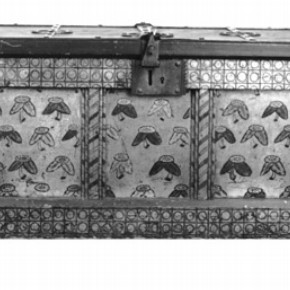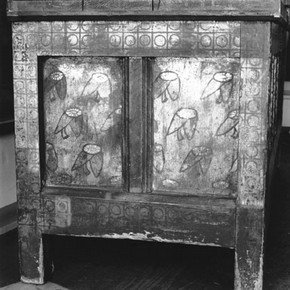Conservation Journal
April 1996 Issue 19
Preparing for Morris - the Treatment of a Philip Webb Painted, Silvered Chest

Figure 1. Philip Webb Chest. Museum no. W.35-1978. Photography by V&A Photographic Studio (click image for larger version)
In preparation for the forthcoming William Morris exhibition, a small chest (Museum no. W35-1978) which was acquired by the V&A in 1978 has recently undergone conservation treatment in the Furniture Conservation Studio (Figure 1). The chest does not have a well documented history, however, it is believed to have been exhibited in the Medieval Court at the London International Exhibition in 1862. Though it was not listed in the exhibition catalogue, it is mentioned in at least one of the journalistic accounts of the exhibition and is also alluded to in the account book of Philip Webb, who designed for Morris, Marshal, Faulkner & Co. (it was not uncommon for some firms participating in the exhibition to display objects not listed in the catalogue while others were unable to complete and display objects which were listed).
The decoration used on the chest: a grid of circles and lines, diagonally-striped stiles (vertical wood supports), and stylised daisies on inset panels is comparable to decorative elements in the Red House which was designed by Webb for Morris in 1858. The simple form and construction of the chest, the bold geometry of the metal work, and the silver leaf over a dark grey gesso ground, all point to this piece being an early example of the revival of painted decoration for Gothic furniture. There are also several details that seem to suggest that this was an experimental piece. These include the overall use of silver leaf in areas which were later covered with paint, filled holes in the top rail (horizontal wood support), a lock which does not properly fit the place it was designed for, and a punch-marked design on the top back rail that was abandoned after several inches.
This chest is important not only because it is probably one of the earliest pieces of the Morris 'Gothic' painted furniture to survive but also because the stylised painted decoration, which later lead to the use of formalised inlay, is not seen on any other furniture from this date.
Condition

Figure 2. Webb Chest showing damaged end. Photography by V&A Photographic Studio (click image for larger version)
Structurally, the chest was very sound and with the exception of one end (Figure 2), the finish appeared to be intact, although it was covered with a heavy grime layer of wax and dirt. The tinted varnishes on the damaged end had been removed at some point, exposing the silver leaf to further degradation. In some places the silver had also been worn away leaving a ghost impression of the painted design on the remaining grey gesso ground. Cross-sections, examined microscopically, confirmed the extent of the damage. They also confirmed the finish stratigraphy on sound areas: a grey gesso ground followed by a gold size, then silver leaf coated with several layers of tinted (pigmented) spirit varnish, followed finally with painted decoration. At the base of the chest, the bottom rails and the edges of the feet were abraded, exposing raw, damaged wood.
Treatment
The abraded edges on the rails and feet were sealed with animal glue and then inpainted with pigments in 10% Paraloid B-72™ (Rohm & Haas Co.), an acrylic resin, to match the mottled grey gesso background.
The entire surface of the chest was cleaned with cotton swabs and Shellsol A™ (Shell), a light aromatic. This cleaning was monitored with the aid of a stereomicroscope to make sure that no finish was removed. The red painted top and metal strapwork was then waxed with microcrystalline wax and buffed. The rest of the chest was sealed with Lank's brushing varnish (Ketone N resin™(Picreator) in Stoddard solvent).
The proper right side of the chest was heavily degraded and required special attention. Because of the importance of the chest and the fact that it would be on display in the Morris exhibition, the decision was made to restore the damaged end to bring back some coherence to the overall aesthetic of the chest. The right facing panel and the two legs on this end were toned using a yellow pigment in 10% Paraloid B-72. The left facing panel was toned with an orange pigment to follow the original alternating paint scheme. On the top and bottom rails the silver was completely gone and only a ghost image of the grid and circle decoration remained. A long (18 hour) gold size was applied around the lines and circles and then gilt with silver leaf the following day. The areas which had originally been silver gilt on the diagonally-striped centre stile were also re-gilt. The petals of the stylised daisies and the areas originally coloured on the centre stile were tinted with pigments in a 10% Paraloid B-72 glaze. Their original colours were determined from the fragments which remained and from the overall alternating pattern used on the rest of the chest. The outlines of the flowers, the striping on the centre stile, and the lines and circles were made more clear and discernable by over-painting with a thin glaze of pigment in 10% Paraloid B-72. The entire surface was then coated with Lank's varnish, modified with 5% microcrystalline wax. After one week the chest was buffed lightly with microcrystalline wax.
Note
The Furniture Conservation Section is very grateful to John for his expert treatment on this difficult and demanding project. The completed chest will be one of the objects on display in the William Morris Exhibition which runs from 9 May until 1 September.
April 1996 Issue 19
- Editorial
- Preparing for Morris - the Treatment of a Philip Webb Painted, Silvered Chest
- Conservation Course Abstracts: Update
- Conservation Liaison - Stained Glass for the William Morris Exhibition
- Digital Imaging and Stained Glass Conservation
- The Restoration of the East Staircase Ceiling and the Leighton Corridor, Victoria & Albert Museum
- The 'Leighton Project': Backstage
- Printer Friendly Version